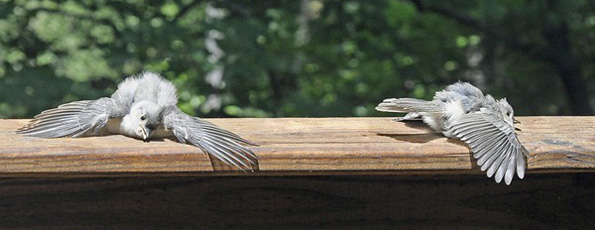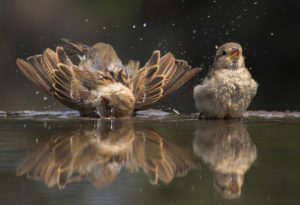

Bathing & Dusting
 When birds bathe in water or saturate themselves with dust they are actively maintaining their plumage. In well-watered areas, bathing is most common. In arid ones, dusting is more often observed. Frequent dusting helps to maintain an optimum amount of oil on the feathers. Excess plumage lipids, including preen oil, are absorbed by the dust and expelled along with dry skin and other debris. Without dusting, feathers quickly become oily and matted.
When birds bathe in water or saturate themselves with dust they are actively maintaining their plumage. In well-watered areas, bathing is most common. In arid ones, dusting is more often observed. Frequent dusting helps to maintain an optimum amount of oil on the feathers. Excess plumage lipids, including preen oil, are absorbed by the dust and expelled along with dry skin and other debris. Without dusting, feathers quickly become oily and matted.
Wrens and House Sparrows frequently follow a water bath with a dust bath. Overall, the amount of time and effort birds put into bathing and dusting indicates how critical feather maintenance may be. Feathers are marvelous and intricate devices, and keeping them functional requires constant care.
 The frequency of bathing by land birds typically is related to the weather. On a hot summer day, titmice or chickadees may take five baths; in midwinter they still may bathe several times a week, often in snowmelt found in protected areas.
The frequency of bathing by land birds typically is related to the weather. On a hot summer day, titmice or chickadees may take five baths; in midwinter they still may bathe several times a week, often in snowmelt found in protected areas.
After bathing, birds dry themselves using ritualized movements. Even swimming birds must force the surplus water from between their feathers to protect their insulating properties. Sunbathing, which occurs in many birds, may stimulate skin parasites into activity so they can be more readily picked off. Songbirds shake themselves to throw off water by vibrating wings and tail and ruffling feathers. All birds normally follow bathing with preening.
 For some species that live in areas where standing water is not readily available, dusting appears to substitute for water bathing. Birds create dust wallows by scraping the ground. They throw dust over their bodies and rub their heads in the wallow. The dust is first worked through the feathers and then shaken out. Wrens, House Sparrows, Wrentits, larks, game birds, and some raptors are among the North American birds known to dust. As with water bathing, different species tend to have somewhat different dusting routines.
For some species that live in areas where standing water is not readily available, dusting appears to substitute for water bathing. Birds create dust wallows by scraping the ground. They throw dust over their bodies and rub their heads in the wallow. The dust is first worked through the feathers and then shaken out. Wrens, House Sparrows, Wrentits, larks, game birds, and some raptors are among the North American birds known to dust. As with water bathing, different species tend to have somewhat different dusting routines.
Hey, that’s a excellent article. Honestly enjoyed reading this. Bye for now